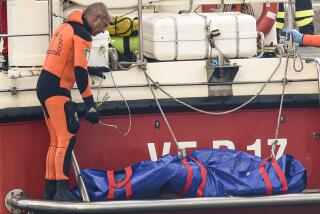Boat industry sees sales rise after some disastrous years
It’s official: The boat industry is no longer sinking.
For the first time since 2006, sales of new boats and boating accessories were up last year, according to a report by the National Marine Manufacturing Assn.
Industrywide sales were up 6%. That was mostly due to the upswing in purchases of equipment and other accessories — new boat sales were up just 1.8%.
But after several disastrous years, the industry was more than willing to embrace any positive news.
“With the recession, it was just like sales fell of a cliff and just kept going,” said Mike Davin of Boating Industry magazine. Then last year, “for the first time, sales were going into positive territory.”
It wasn’t yachts or powerboats that led the charge in getting boat sales out of the doldrums. It was the humble pontoon, a lake-dwelling vessel that is essentially a floating platform with a power motor and, typically, a retractable awning.
These boats are not built for adventure, speed or exploring far-off lands. They’re strictly for fun.
“It’s a ski boat, a party boat, a camping boat,” said Eric Quilliam of Sun Country Marine in Ontario. “It’s a multi-functional boat, which makes it more justifiable.”
The boat has even inspired a popular country song, “Pontoon,” performed by the band Little Big Town. The song calls the boats a “Party in slow motion / Out here in the open.”
New pontoon boats start at less than $10,000 and go up into six figures depending on size, amenities and materials.
Retired police officer Daril Godinez of Fredericksburg, Va., takes his family out on a 22-foot pontoon he bought used. He likes the social aspect of it. “People tie up together and you can go from boat to boat to boat,” said Godinez, 52.
The engine, he said, is powerful enough for water skiing and other sports.
“When you think of a pontoon, you think of like a party barge,” he said, “but it’s really evolved over the years.”
Taking all new boats into account, in 2011 U.S. consumers bought more than 527,000 of them. Total spending on the sector — including new and used boats, plus accessories and services — totaled $32.3 billion for the year. That was up from $30.4 billion in 2010, but far short of the 2006 level of $39.5 billion.
Davin said the improvement has been continuing into 2012. “This year there was concern that these really good sales numbers, that it was due to nice weather,” he said. “But now it’s further into the summer and sales are still good.”
The market for boats is full of “pent-up demand,” said Dave Geoffrey of the Southern California Marine Assn., a regional affiliate of the manufacturing association. “People have been waiting on the sidelines for the economy to get better, and eventually they say, ‘I’m not going to live forever.’”
Anchorages at local docking facilities are selling better, said Debbie Talbot of the Los Angeles County Beaches and Harbors Department.
The upturn marks a major turnaround for an industry that has seen its enthusiasts abandon boating as a hobby — sometimes literally.
Along the California coast, hundreds of boats were reported abandoned in their slips after the owners stopped paying rental and other fees. Some boats were even hauled out on the ocean and then left there to sink or wash ashore. Last year the state spent $500,000 on collecting the illegally abandoned boats.
The situation got so bad, the state Legislature created a boat surrender program that went into effect in 2010 to let owners turn over their no-longer-wanted vessels to authorities.
“It’s much cheaper to have someone surrender their vessel than to dig it out of a slough,” said Denise Peterson of the California Department of Boating and Waterways. Unless a law enforcement agency decides an abandoned or surrendered boat is valuable enough to be sold or donated to charity, the state requires the vessel to be destroyed to prevent it from being abandoned a second time.
Quilliam said that many boat dealers in Southern California went out of business during the recession. He was able to stay afloat by selling three of the top brands that appealed to higher-income people. “I think maybe that income bracket has been more stable than the mid-level bracket has been,” Quilliam said. Other boat dealers echoed this sentiment.
“Big money’s still got big money,” said Marina del Rey yacht dealer Mike Leneman.
Used boat sales fell 9% in 2011, although they accounted for 83% of all boat purchases that year.
In order for sales to stay on the upswing, some industry observers said, manufacturers will have to increase their output of modestly sized boats.
“For the young family that thinks they might want to try boating,” said Ben Sherwood, an industry veteran who blogs about boat marketing, “it’s hard to find entry-level boats there that are affordable. Most of the manufacturers are building larger, expensive boats tricked out with all kinds of bells and whistles.”
But if young families get involved in boating now, “down the line they can afford a more expensive boat,” Sherwood said.
A robust recovery for the industry probably can’t come until the rest of the economy shapes up, Davin said. After all, recreational boating is not a necessity, and it can be expensive.
“The broader economic trends have a huge effect on the marine industry,” Davin said. “It’ll be nice when we see some recovery in the housing market. Until that happens, it’s going to be hard for boating to completely recover.”
More to Read
Inside the business of entertainment
The Wide Shot brings you news, analysis and insights on everything from streaming wars to production — and what it all means for the future.
You may occasionally receive promotional content from the Los Angeles Times.










